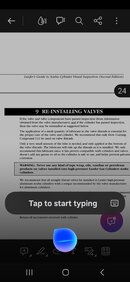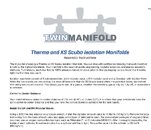[...]
Can you elaborate on how this water got there in the first place, please.
[...]
The water ingested by cylinders always comes from two sources. One scenario is that the cylinder was emptied completely and the valve left open. This happened to the fleet of cylinders I briefly mentioned in my last sentence.
The other scenario involves a malfunctioning compressor. The compressor's last filter, the one with the molecular sieve, only filters out a tiny amount of moisture from the air. The vast majority of moisture is expelled earlier in the cyclone separators and the clever implementation of a PMV. In the tropics at 35°C, you will get around 150 mL of water per S80 filled. If the PMV and cyclone separators are malfunctioning, the final filter and molecular sieve are overwhelmed after filling just a handful of cylinders. This last example is extremely common in dive centers in the tropics.
The first thought is, if lubricant is trapping water in, why is it not trapping water out?
Absolutely fair point, and I guess it does to some degree. Unfortunately, the lubricant is not static and will move around ever so slightly. Think about a diver making a back-roll from a boat with a cylinder having half a liter of water inside. That water will come rushing down towards the valve and hit the lubricant, ever so slightly dislodging it.
Or it may not, but the point is that it can. While most lubricants are awesome at being very hydrophobic, some people use whatever they have at hand. This can result in the lubricant "catching" the water. Even hydrophobic lubricant can in unfortunate situations create a barrier or obstruction that the moisture has a hard time to escape.
Furthermore, the valve is the part that sees the highest temperature swings when using or filling a cylinder. Moisture is suspended in the gas that you are filling. This suspended air of course penetrates between the threads, up to the O-Ring. On temperature changes, this suspended water can condense between the threads.
A second point you made said lubricant is ineffective in creating a barrier between the thread of the valve and the thread of the tank because the lubricant would be squeezed out due to the extreme force between the threads, leaving only a thin layer of lubricant. Yet you state water is trapped in the threads, in the very place where lubricant is squeezed out, and the lubricant itself is what is trapping water there, although according to you, there’s no room for the lubricant to be there.
I guess I worded this poorly, apologies. Think about two threads meeting each other, with the male threads getting pushed extremely hard into one direction, parallel to the female thread, not perpendicular to it. Let us assume that the crests of the male thread will be pushed upwards. That upward pushed crest will leave a small gap underneath itself and the lower female thread. Maybe this picture can convey better what my poor wording can't.
Note that I have drawn this extremely exaggerated. Tolerances on a real M25x2 6g thread are fairly small, but they still do leave a small gap underneath the crests as shown in the picture.
I’m not really trying to make a point for or against lubricant here, just trying to understand how those statements you made make any sense
I'm absolutely with you here, lubrication of cylinder threads is a delicate thing. One seems to loose whether you do or whether you don't. I can easily see the arguments on both sides of the aisle, but from personal experience I made the choice mentioned above.





